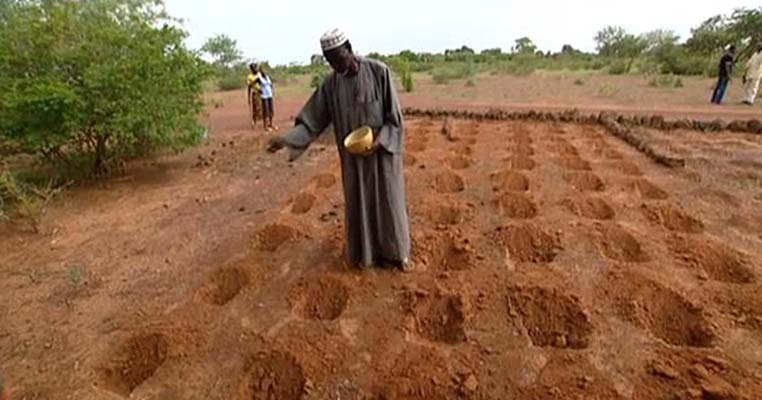Een prachtige documentaire over hoe Yacouba Sawadogo de woestijn tegenhoudt en de Sahel woestijn weer vruchtbaar weet te maken.
 Na het eerste deel van deze serie waarin een stuk woestijn in het Midden Oosten in Jordanië werd hersteld nu een voorbeeld uit Afrika waar de Sahel woestijn wordt teruggedrongen op een simpele manier. Bekijk het prachtige verhaal van Yacouba Sawadogo die laat zien hoe 1 persoon letterlijk de woestijn kan tegenhouden. Wat zou er gebeuren als inplaats van 1 persoon, duizenden mensen deze simpele technieken leren en toe gaan passen?
Na het eerste deel van deze serie waarin een stuk woestijn in het Midden Oosten in Jordanië werd hersteld nu een voorbeeld uit Afrika waar de Sahel woestijn wordt teruggedrongen op een simpele manier. Bekijk het prachtige verhaal van Yacouba Sawadogo die laat zien hoe 1 persoon letterlijk de woestijn kan tegenhouden. Wat zou er gebeuren als inplaats van 1 persoon, duizenden mensen deze simpele technieken leren en toe gaan passen?
One effect of the drought was widespread desertification. Combined with other factors such as overgrazing, poor land management, and overpopulation, the drought led to a substantial increase in barren land, particularly on slopes, due to the comparative difficulty of cultivating sloping land. Uncultivated, the soil experienced increased erosion and compaction. Together with Mathieu Ouédraogo, another local farm innovator, Yacouba Sawadogo began experimenting with techniques for rehabilitating damaged soil in about 1980. He relies on simple approaches traditional to the region: cordons pierreux and zaï holes. Both Sawadogo and Ouédraogo have engaged in extension and outreach efforts to spread their techniques throughout the region.
Cordons pierreux are thin lines of fist-sized stones laid across fields. Their purpose is to form a catchment. When rain falls, it pushes silt across the surface of the field, which then fetches up against the cordon. Slowing down the flow of water gives it more time to soak into the earth. The accumulated silt also provides a comparatively fertile spot for seeds of local plants to sprout. The plants slow the water even further in turn, and their roots break up the compacted soil, thereby making it easier for more water to soak in.
Zaï holes also catch water, but take a slightly different approach. They are holes dug in the soil. Traditionally they were used in a limited way to restore barren land. Yacouba Sawadogo introduced the innovation of filling them with manure and other biodegradable waste, in order to provide a source of nutrients for plant life. The manure attracts termites, whose tunnels help break up the soil further. He also increased the size of the holes slightly over the traditional models. Zaï holes have been used to help cultivate trees, sorghum, and millet.
Over a period of more than two decades, Yacouba Sawadogo’s work with zaï holes allowed him to create a forested area of approximately fifty acres.
 Op de hoogt blijven van nieuwe berichten? Like ons op facebook en/of volg ons op Twitter!
Op de hoogt blijven van nieuwe berichten? Like ons op facebook en/of volg ons op Twitter!
Een nieuw gezichtspunt leren kennen, iets geleerd en/of gelachen? Overweeg een donatie/vrijwillig abonnement.
Aanverwante artikelen en informatie
-) Website – The Man Who Stopped The Desert
-) Ecosysteem herstel is simpel – deel 1
-) Roeland Lelieveld vergroent Kenia
-) Website Permacultuur Nederland
-) Website Eetbaar Nederland
-) Nederlandstalige facebookgroep over permacultuur (6000+ leden)
-) Overige netwerken en platformen van Permacultuur in de Nederlandse taal
-) De 7 lagen begroeiing van een eetbare bostuin
-) Het belang van gezonde, levende gronden
-) Bouw je eigen geodome broeikas
-) Zaden en plantenruilsysteem van en voor alle Nederlanders

And the desserts shall be green again…
Bless the people who make it happen!
En ga er vooral zelf ook mee aan de gang en verspreid de informatie.
In Nederland is ook genoeg te doen op dit gebied. Om te beginnen een voedsel bos voor elke stad en dorp in Nederland!
—–
Eetbare bostuinen zijn een populair onderdeel van permacultuur. Door verschillende ontwerpprincipes van de permacultuur te gebruiken is het voor iedereen mogelijk om een bos te ontwerpen vol met eetbare en andere nuttige planten.
http://www.permacultuurnederland.org/wp/de-eetbare-bostuin/
Heb eens met die mensen gesproken, bijzonder was dat ook Al Qaida geen ‘klanten’ meer kan ronselen. Het idee is eenvoudig, als mensen het beter hebben dan zijn ze minder geneigd zich te laten verleiden tot barbaarse acties. Ondernemers zonder grenzen, ook in het Nederlands 🙂
http://www.ozg.be/#!
Als mensen het lokaal naar de zin hebben en het gevoel hebben dat ze hun situatie kunnen verbeteren dan zijn de meeste mensen meer dan gelukkig.
Ik denk dat permacultuur daarom een prachtige toekomst kent. Het laat mensen weer in harmonie met de natuur samenwerken.
Dat zou alvast een paar kopzorgen minder betekenen, er zijn er in deze wereld nogal wat. 🙂